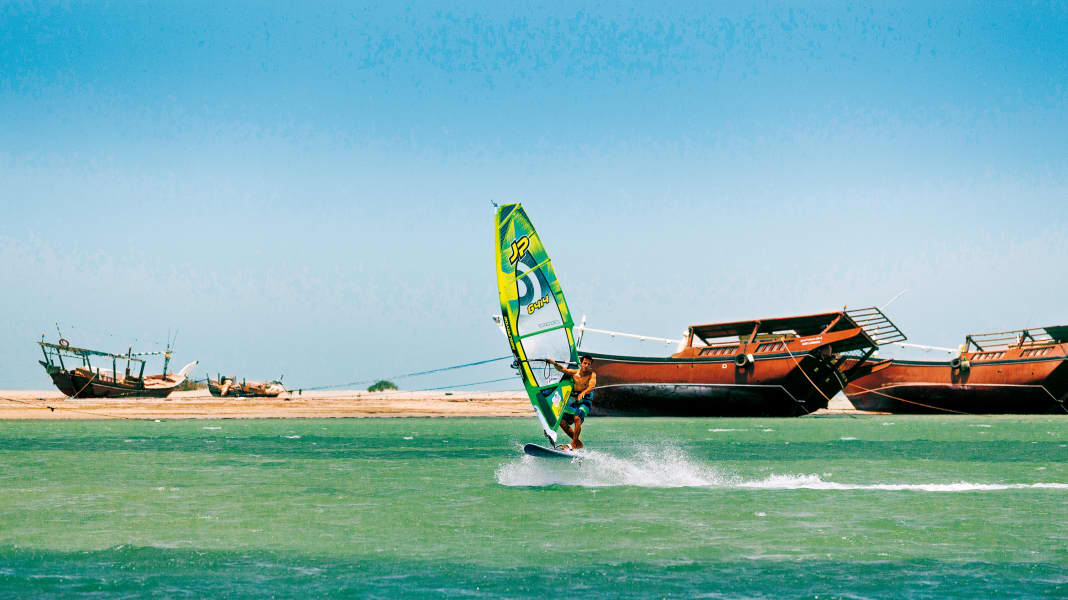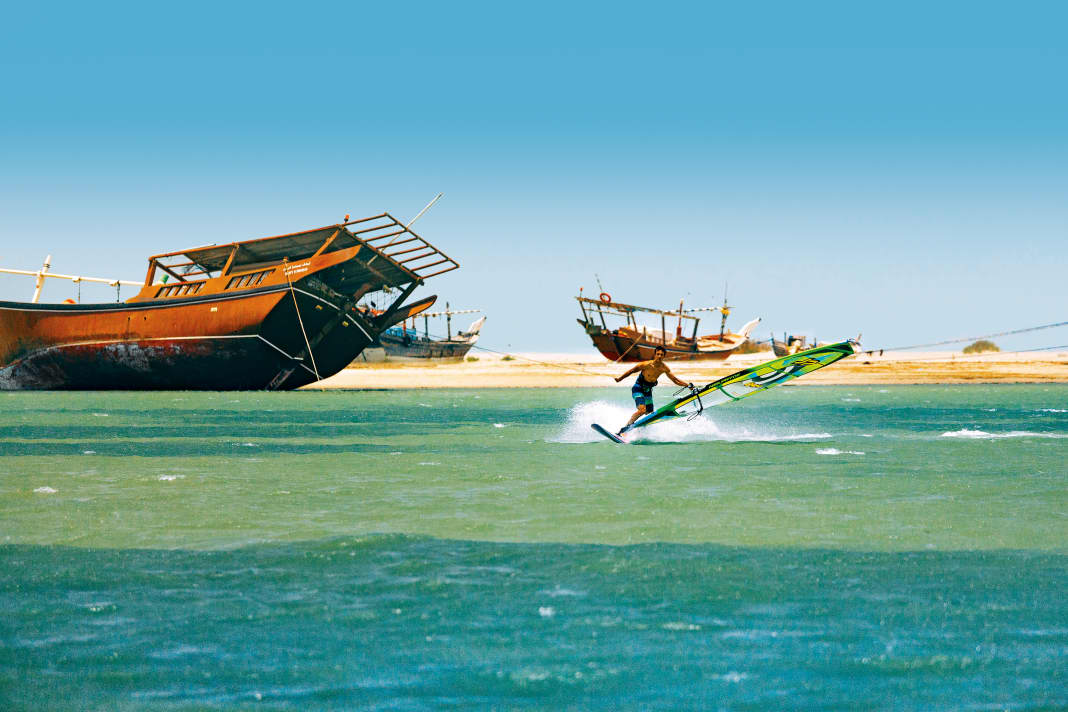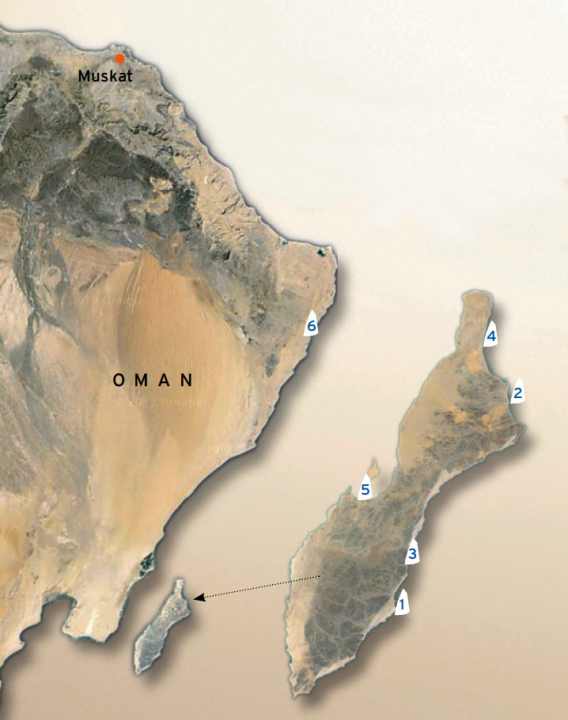






It is seven o'clock in the evening in Muscat. A horn sounds and the city gates close with a loud screech, as they do every day at this time. Anyone who is not yet inside the four metre high walls will have to wait until sunrise. Until then, all access to the capital of Oman is denied and nobody can get in or out. What sounds like a medieval scenario was just forty years ago - about as long ago as the invention of windsurfing. At the same time, Oman had just ten kilometres of paved roads, hardly any medical care and three schools.
And today? Today I'm standing here in Muscat in a shopping centre that's open late into the night, trying to buy toothpaste. The shelves are about as high as the city wall and two city gates wide. A four-lane highway leads to the huge mall, whose car park is paved with pick-ups and Land Rovers. I remember the headline in a travel guide: "If you're looking for the original Arabia, you'll find it in Oman". My travelling companion Joseph and I quickly agreed: Muscat is a modern and spotlessly clean city whose palaces and mosques still exude a touch of the charm of a thousand and one nights. However, we would not find the promised, original Arabia here.
But what had happened in just four decades? The short version: the reigning sultan overthrew his father from the throne in the early 1970s and led the country from backwardness and isolation to modernity within a very short space of time, financed of course by the oil business. The black gold built schools, universities, hospitals and roads. And if the Omanis still demand an increase in pocket money in the manner of spoilt children, the Sultan responds like an ingratiating (national) father by waiving tax revenues or cancelling all private debts, as happened on the occasion of his twentieth anniversary on the throne. But the plan seems to be working: in the midst of politically volatile countries such as Iran, Saudi Arabia and Yemen, the Sultanate seems to radiate meditative calm. The population is content, the political situation is stable and crime is virtually non-existent. The fact that the Arab Spring also flared up briefly in Oman does not change this. The first man in the state waved the oil dollars once again - for example, all students received an interest-free immediate loan of 6,000 riyals (just over 10,000 euros) - and the movement was nipped in the bud.
As a tourist, you can move around safely and freely in Oman. According to the Foreign Office, the greatest source of danger are free-roaming camels that suddenly lurk behind a bend on the motorway. But all the happy citizens and empty prisons seem to have prompted the Sultan to make some outrageous laws. A dirty car is actually considered a traffic offence in Oman - a proud regulation for a desert state with a water shortage. Running stop signs or traffic lights is also not recommended in the Sultanate. Instead of a fine, you can expect three days in jail.
Anyone who still thinks we Germans are a stuffy nation when it comes to traffic rules is welcome to reconsider. We had the opportunity to do so at the border from Dubai to Oman, where our road trip almost ended before it had even begun due to bureaucracy and moody officials. Two customs officers didn't like the fact that we were carrying 50 kilos of surfing luggage on the roof of our Toyota Corolla. There wasn't much we could argue with the two officials, who were visibly upset by the fasting month of Ramadan and temperatures of 47 degrees. Without much discussion, they refused to let us cross the border. "This Oman. Our country, our rule!" was their reasoning.
A two-hour luggage redistribution operation on the barren mountain pass in the scorching midday sun brought us close to circulatory collapse, but not across the border. It was only thanks to our many years of experience in discos that we were prepared for the phrase "you can't get in here" and knew what to do if the doorman didn't like the shoes you were wearing: you simply borrowed another pair and threw them back at the donor through the toilet window. In our case, the replacement pair of shoes consisted of an Englishman in a spacious jeep who transported our equipment across the border. Meanwhile, we told the officials that we would only put the board bag back on our car once we had swapped our Asian Trabi for a spacious pick-up at the next car hire company. Unfortunately, we couldn't quite keep our promise.
However, the next border experience was not long in coming. After the aforementioned stopover in Muscat, we headed inland - after all, the real, authentic Bavaria is more likely to be found in Benediktbeuern than in Munich. Old fortresses and castles, the last witnesses to Oman's eventful past, remote villages and an unspoilt lunar landscape as far as the eye could see proved us right in this respect. Unfortunately, we also found the reason for the relaxed attitude towards wild camping, which is tolerated without restriction throughout the country: it's usually too hot for it anyway. No matter where we pitched our tent and how exhausted we were, sleeping was out of the question with night-time temperatures still hovering around 40 degrees. At this point, I would like to say that our ecological conscience prevented us from spending the night in the car with the engine running and the air conditioning on. But after almost two days without sleep and the exhausting heat, we probably wouldn't have cooled our car down even with a nuclear reactor. So it was probably more due to the limited fuel capacity that we continued our journey towards Masirah, the wind and wave-spoilt island in the Gulf of Oman.
Sindbad's travels
In a Sahara-like landscape near the coast, a pleasant, 33-degree "cool" breeze finally blew, so that we slept for a few hours under a starry sky that you only see in the desert. The next day finally rewarded us for all our exertions: in a so-called wadi, a dried-up river course in mountain valleys that carries water even after distant rainfall and gives rise to lush vegetation, we learnt the meaning of the term oasis and came to love it. The city of Sur, our last stop before Masirah, looked like a backdrop from "Sinbad's Travels". Castles, watchtowers and a huge natural harbour reminded us of times when the town was one of the major trading hubs in Arab trade. Together with the well-kept cityscape and a modern suspension bridge, tradition and the 21st century blurred before our eyes in the harbour town.
Masirah finally welcomed us with drizzle and windsurfing in homeopathic doses. Many of the other windsurfers were talking about the worst forecast for years. However, as I still got out on the water almost every day, albeit with light winds and small waves, the last few years must have been quite impressively ventilated. After all, all that waiting for wind brought interesting insights.
It turned out to be very pleasant that there were no package tourists thanks to the lack of package holidays. We quickly made contact with the few other travellers and listened to stories that you rarely hear on a holiday from a brochure. For example, that of a Swiss couple who bury all their surfing equipment at a certain spot in the sandy desert of Masirah every year so that they can at least travel comfortably without boardbags due to the poor flight connections from their home country to Oman. Or the French diplomat who kept disappearing for a few days at a time to hunt down terrorists in Pakistan, but spent the time between his missions windsurfing in Oman to relax. We met two Englishmen who had well-paid jobs and families in Dubai, but spent their weekends and holidays on Masirah in the best hippie style in a self-built beach camp with camp beds, barbecue area and beach shower. Their pride and joy: a large freezer full to the brim with dry ice and beer smuggled across the border.
We bumped into a German expatriate who seemed to be extremely happy with his life in Oman: skiing in Iran in winter, kitesurfing on Masirah in summer, touring the Saudi Arabian desert in a former Bundeswehr vehicle in between and an income that leaves 100 per cent net from the gross. And then there was a vociferous group of Italian travellers who arrived in a party of 15 and made sure that we voluntarily postponed the first session of the day until dawn.
Tradition-conscious, but cosmopolitan
But even though the wind only returned to its usual strength on the day of our departure, the island had cast a spell over us. The locals were friendly and pleasantly reserved at the same time. You can tell that we - the colourful swimming trunks group - are still exotic visitors from another world for the men and women in their floor-length, elegant frocks. That we are perhaps even ridiculed a little here for taking on the hardships of a pilgrimage for the long journey to their island and the brief happiness in the waves. We, the exemplary representatives of the Western fun society. Nevertheless, the relationship is characterised by mutual respect.
Unlike in certain areas of Egypt or Morocco, where locals and tourists have become accustomed to each other in an almost unbearably hard-boiled manner, you won't see any dollar notes in circulation here. In Masirah, too, we know that the country's riches will not bubble up from the earth in the form of black gold forever.
People are looking around for alternatives, building hotels and hoping for tourists. Nevertheless, there are no souvenir shops on Masirah, nor are there any pushy traders or begging children. Despite being one of the larger tourist regions in Oman, the island has remained an unspoilt corner of the Arabian world and is therefore a little like the country as a whole: cosmopolitan but tradition-conscious. Ready for change, but proud of its past.
INFO OMAN
Weather, wind and waves: The south-west monsoon ventilates Oman from May to September with more than 80 per cent of gliding wind, and in July and August it blows almost daily. At all spots on Masirah [except the G-spot], the wind takes a short break at midday and is strongest in the morning and late afternoon at around 20 to 25 knots. The all-purpose weapon in Oman is the 4.7, at the G-Spot it can also be smaller.
Most of the wave spots are very moderate with wave heights of between one and one and a half metres and are suitable for climbers; they work regardless of large swells. With rare swells from the south to south-east, the waves can sometimes go towards "mast high".
Travelling and material transport: If you book early enough, you can fly with Turkish Air from almost all German airports to Muscat via Istanbul for less than 500 euros. Air Berlin, Lufthansa, Emirates and Etihad are slightly more expensive, but also fly to the capital of Oman. In our experience, Turkish Airlines is the most convenient way to take your board with you, costing 90 euros each way. As you can't hire equipment locally, you can't avoid taking boards with you.
It takes four to five hours to get from the airport to the ferry to Masirah Island in a hire car. The ferry departs several times a day, takes around two hours to reach the island and costs less than ten euros, including the car.
Flights to Dubai are slightly shorter and cheaper, but the journey to the ferry takes around ten hours.
The infrastructure in Oman is of European standard - road signs are in both Arabic and Latin letters, the motorways are well developed and you can get to all spots without a 4x4.
Climate and choice of neoprene: In the months from June to August, the climate is sometimes challenging, especially inland. The thermometer can rise to 45 to 50 degrees here, but at least the air is dry. It is bearable near the coast. Temperatures on Masirah average 27 degrees during the day and are pleasantly cool at night. The water temperatures in summer are between 28 and 30 degrees, making a shorty or steamer the ideal choice for surfing.
Overnight stay:There are five hotels of European standard on Masirah, with a room and breakfast starting at 35 euros. The Masirah Island Resort is in the upper price range, but scores with four stars.
Flats are also easy to find; telephone numbers for booking are often written on houses in the city.
At the kite station near Sur, you can rent a beach hut for around 20 euros/night, and for two euros you can get a pitch in the shade and use the showers, toilets, etc.
Prices: The cost of living in Oman is almost unbeatably cheap. You can get a good meal in a restaurant for three euros, including a drink. With a price of 13 cents per litre, fuel costs are virtually non-existent.
Dangers: Oman is an absolutely safe country to travel to! In fact, camels pose the greatest danger on the roads. Nevertheless, out of respect for the locals, you should not dress too revealingly.
SPOTS
Windsurfing in Oman is no longer an insider tip! During the main holiday season in July/August, there are easily 30 to 50 windsurfers on Masirah. On normal days, the action is spread over several spots, but it gets crowded when the forecast is bad and only the G-spot is working in the evening. If you want to have the good waves to yourself, you have to get up early, but there is always plenty of space in the Sur lagoon.
The spots on Masirah are usually only 200 to 500 metres away from the main road. If you keep your eyes peeled for cars with surfing gear on the roofs, you can still easily spot the gravel paths that turn off the road without any signposting or geographical clues. To be on the safe side, use a navigation device that processes geodata. This is particularly useful for spots on the mainland. Windguru provides the geodata for each spot.

1) Khazit
[Long: 20.292149 / Lat: 58.776260]
The wave spot you can never go wrong with. Works equally well at all tide levels, with virtually no shorebreak thanks to sufficient run-up to the surf zone. The wave runs around a headland far into the bay and offers great riding conditions with wind from the right. Those who venture deep into the wave on the first turn will get a powerful Ponta Preta-quality section. Further downwind, however, the wave is harmless but still clean.
2) G-Spot/Alghery
[Long: 20.546680 / Lat: 58.935936]
A beach break that doesn't allow endless rides, but is always the best ventilated. As long as the wind direction is right (side-offshore from the right), the sail sizes get continuously smaller during the course of the day, and towards evening it likes to blow at 40 knots and more. However, the waves only get really steep for one or two hours at low tide. Then the spot also shows where it got its nickname G-Spot from and reveals a small round rock in the shore area, which lies just below the water surface at high tide. However, a flag positioned on the beach as an extension of the rock helps to locate it.
3) Haqal
[Long: 20.358263 / Lat: 58.797821]
Powerful point break with wind from the right, which shows its strengths all the more the higher the S-SO swell gets. Works at any tide, but if you get too deep into the wave you run the risk of riding over individual rocks lurking just below the surface. Low water provides a clear view of these and is better suited to familiarising yourself with the wave. Rather a spot for experienced surfers!
4) Airbase
[Long: 20.6397 / Lat: 58.9044]
Those who like to catch the early bird have the best chances near the American airbase. Although the wave is higher in the south of the island, the wind is stronger here in the morning and blows a little more offshore than at the other wave spots from the right across the beach break. The offshore wind forms a steep, fast wave. As the shorebreak and wave height are unproblematic at the same time, everyone can enjoy a down-the-line ride at top speed here. However, more than two turns are rarely possible.
5) Sur Lagoon:
[Long: 20.429761 / Lat: 58.717181]
One of many perfect shallow water spots on the west side of Masirah. Large bay with a long standing area and therefore ideal for freeriders, freestylers and intermediates. The kite centre (www. kiteboarding-man.com ) is well organised and offers equipment storage, sanitary facilities, cheap accommodation and a small restaurant. Unfortunately, it is not possible to hire windsurfing equipment or book courses.
6) Al Ashkara/ Fisherman's Bay:
[Long: 22.036715 / Lat: 59.674072 ]
Longest wave in Oman when fed with at least two metres of swell from S-SE. Heading north from Al Ashkara, 25 kilometres after the village, you turn right off a newly built bypass onto a headland, with signs pointing the way to the hotel resort located there. The wave breaks like a string of pearls around a cape, but less powerful than Haqal or Khazit and therefore also suitable for wave novices. The wind blows sideshore from the right and is generally about one wind force weaker than on Masirah.

